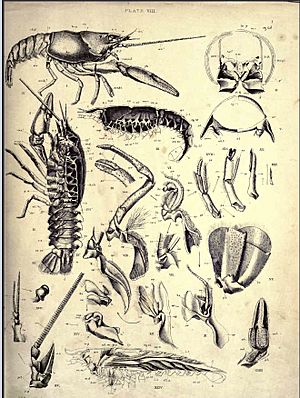George Bond Howes facts for kids
Thomas George Bond Howes (born September 7, 1853, died February 4, 1905) was an important English zoologist. A zoologist is a scientist who studies animals. He was also a Fellow of the Royal Society, which is a very old and respected group of scientists.
Contents
Life and Work
Thomas George Bond Howes was born in London, England. He was the oldest son of Thomas Johnson Howes and Augusta Mary Bond. His mother's father, George Augustus Bond, was a captain in the East India Company.
Becoming a Scientist
In 1874, Thomas Howes met a famous scientist named Thomas Huxley. Howes was very good at drawing and loved nature. Because of these skills, he became Huxley's assistant.
Howes helped to create a new way of teaching biology. This was at the Normal School of Science and the Royal School of Mines in Kensington. In 1880, he became a demonstrator of biology there. This meant he helped students learn through practical lessons.
Teaching and Research
From 1885, Howes worked as an assistant professor of zoology at the Normal School of Science. Later, in 1895, he became the first professor of zoology at the Royal College of Science in South Kensington.
Howes was known as an amazing teacher. The biology courses he taught were very detailed and showed how much he knew. He also spent a lot of time helping to start and support groups that focused on natural sciences. He held important positions in many of these groups.
His drawing skills were excellent. He drew all the pictures for his book, "Atlas of Elementary Biology," which came out in 1885.
Studying Animals
Howes was most interested in the "comparative anatomy of the Vertebrata". This means he studied how the bodies of different animals with backbones are built and how they compare to each other. He made many important discoveries in this area.
One important study he worked on was about the skeleton of the Tuatara. The Tuatara is a special reptile from Norfolk Island. He wrote about this with H. H. Swinnerton in 1901. Another scientist, John Edmund Sharrock Moore, also worked in Howes's lab for many years.
Awards and Recognition
Thomas Howes received many honors for his work:
- In 1897, he became a Fellow of the Royal Society.
- In 1898, he received an honorary degree (Legum Doctor) from St Andrews University.
- In 1899, he received another honorary degree (Doctor of Science) from Manchester University.
He was also a leader in several scientific societies:
- President of the Malacological Society of London (1895-1896)
- Treasurer of the Anatomical Society
- Zoological Secretary of the Linnean Society
- A Member of the Council of the Zoological Society of London
A type of snail, Bathanalia howsei, was named after him to honor his contributions to zoology.
Family Life
In 1881, Thomas Howes married Annie Watkins. They had one daughter together.



